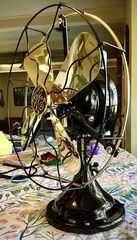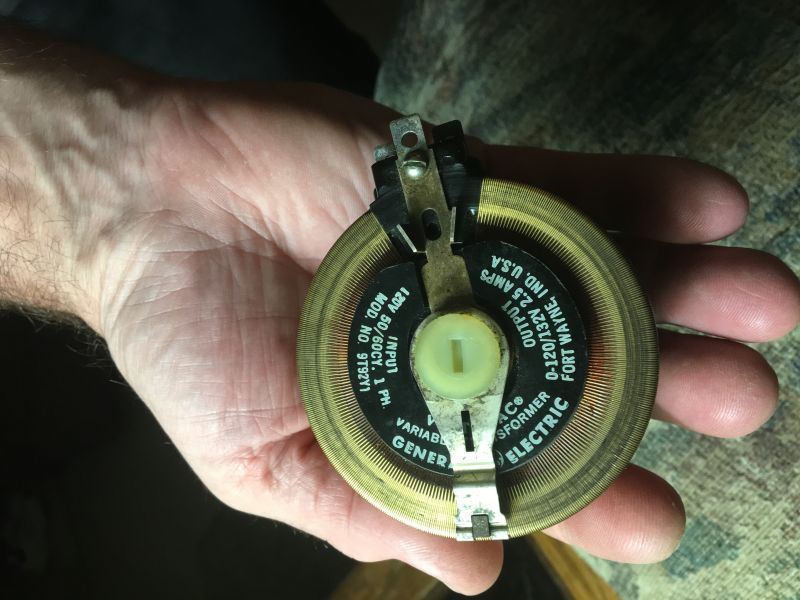Leaderboard
Popular Content
Showing content with the highest reputation on 11/28/2022 in all areas
-
3 points
-
Many fans and motors in the early 1900’s and maybe late 1800’s were designed to run on 104 volts. Running a 104 volt fan on modern 120 v will work, but stresses the motor. The increased voltage also increases the current. 104 -> 120 is a 15% increase. But, this also causes a 15% increase in current. Power = voltage x current. 1.15 x 1.15 = 1.32. So, the higher voltage causes the fan to use 32% greater power (and heat). Not good for a 115 year old rare fan. Sometimes, I simply plug the fan into the 120 v wall outlet, but only run the fan on Low. This uses the fan’s internal speed coil to drop the voltage down to around 108-112 v, depending on the fan. Relatively safe, but not optimum. Most collectors say to use a Variac. This is an autotransformer with a knob to set the output voltage. These are big, heavy, and can output voltage that is higher than the input, so accidentally turning the knob up can really stress or damage your fan. I have a small Variac, made by Superior Electric. It is designed for 115 v input. My house is 122 v. When you set the knob to 104 v, it actually outputs 111 v. Turned fully up, it outputs 143 v. So, to use this on a 104 v fan, you need to set it using a meter and ignore the dial. And, don’t ever turn the knob all the way up. I tested a KB Dial-a-Temp. $37. It can control the speed, but it is not regulated. With the fan off, it always puts out 120 volts. You can turn the fan on High and adjust it for 104 volts, but when you switch the fan to Low, the load is reduced, the voltage increases, and the fan speed dies not change. And, if the fan has a centrifugal start switch, the extra load during start causes the voltage to drop down into the 80’s, making starting unreliable. It’s a good way to slow down a 1920’s desk fan, but it cannot provide a steady 104 v. Next up is a UmiPower LX-500C. $63. It is designed to operate Japanese appliances in the US, so it outputs a regulated 100 v, close enough to 104 v to do the job. This works super well, with no issues, so that is what I’m going to use.1 point
-
Rich Becher did some work to help me in past. always very nicely done. Don't see him much here anymore, but he didn't just talk the talk, he walked the walk. When he put his mind to something, he stuck to it, and he made it happen. GE Kidney Gearbox Bottom Re-pop - Pre-1950 (Antique) - Antique Fan Collectors Association - AFCA Forums1 point
-
1 point
-
This motor is still sitting untouched since purchased the other week, but seller sent a photo the other day of what it originally powered. Maybe the machinists in the group will recognize this lathe and can assist in dating it and the motor. Apparently it was originally from a historic home in the area...1 point
-
Terrific thread with excellent information. Thanks to all contributors.1 point
-
I got some stuff back lately so why not make a post about it? my first brass fan is that 16 stamped steel. Next thing you know, a bmy walks into my path, very special thanks to Dan o’toole and Ben guegain for shipping it out. That thing was crusty and rusty and sad looking. One rundown of restoration brought it back to life thanks to Alex rushing for the switch redo. The Emerson was also from the same guy as the stamped steel, been looking for a minty 79 and my wish came true. Then the vortalex era snapped back into me. Before the stamped steel and the Emerson. Very special thanks to Dave Killnap for letting me buy the pristine fan off him. Then the tank bug came to bite. A 12 led to an explosion to a new motor now waiting for a switch and cage but runs beautifully! But things change when the 12 needed a 16 brother which was bought.1 point
-
I have found in the beginning what looked like lacquer after cleaning etc, was actually where the lacquer had wore off and the exposed tarnished or discolored brass also leaving small pits in the protected metal making it look like a clear coat.If that makes any sense. If it is or it isn’t you can do what you want, but you are going to play hell getting 400 grit scratches out .I personally would start with 2000 and go up or down from there.1 point
-
John and I corresponded over the summer about this very thing. Hope it's ok to share his words. At the time I had a question of whether a router control could be used as a poor man's variac. He responded it chopped up the sine wave. When the conversation shifted to the BN controller, he replied below: Search: Google images for "Triac AC waveform" for examples of what a Triac does to the AC sine wave... Your message peaked my interest of the BN-LINK Exhaust Fan Speed Controller. I bought one, took it apart, and tested it with several different fans. It has a VERY BASIC circuit and does not have the sophistication of the KB Electronics control. It made the lamination's buzz in two of the fans. The fixed minimum speed allows the motor to stall, (Which is not good). Please use a Variac, or a KB Electronics KBWC-15K fan control for your best results.1 point
-
1 point
-
Typically, a 104-volt fan with a speed coil will show little to no speed change running through the gears on 120 VAC. As far as stress on the windings is concerned put the fan on high-speed bypassing the switch coil and after it runs for 15 minutes + put your hand on the motor housing. If the 104 VAC old girl can't hack the 120 VAC stress your hand will tell you the story. 🙂 Same with the speed coil if you're using the lower speeds. Amazon.com: VCT VT-200J Japanese Step Up / Down Voltage Transformer Converts Japan 100 Volts To 110V OR 110V to 100 Volt - 200 Watt,Black : Electronics1 point
-
I love citristrip, it’s about the only thing I can get away with using indoors!1 point
-
1 point
-
Thanks for the information. I was wondering where the Veritys design came from. Nice tid bit of information. The oscillating arm also works for the British double lever.1 point
-
1 point





























